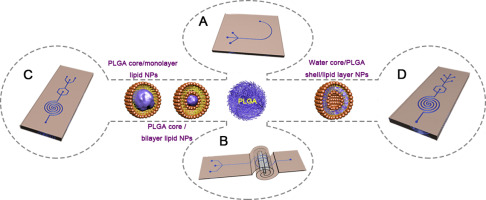Advanced Drug Delivery Reviews ( IF 16.1 ) Pub Date : 2017-12-24 , DOI: 10.1016/j.addr.2017.12.015 Xuanyu Li , Xingyu Jiang

|
Microfluidic chips allow the rapid production of a library of nanoparticles (NPs) with distinct properties by changing the precursors and the flow rates, significantly decreasing the time for screening optimal formulation as carriers for drug delivery compared to conventional methods. The batch-to-batch reproducibility which is essential for clinical translation is achieved by precisely controlling the precursors and the flow rate, regardless of operators. Poly (lactic-co-glycolic acid) (PLGA) is the most widely used Food and Drug Administration (FDA)-approved biodegradable polymers. Researchers often combine PLGA with lipids or amphiphilic molecules to assemble into a core/shell structure to exploit the potential of PLGA-based NPs as powerful carriers for cancer-related drug delivery. In this review, we discuss the advantages associated with microfluidic chips for producing PLGA-based functional nanocomplexes for drug delivery. These laboratory-based methods can readily scale up to provide sufficient amount of PLGA-based NPs in microfluidic chips for clinical studies and industrial-scale production.
中文翻译:

用于制造聚(乳酸-微流控共-glycolic酸)类药物的纳米粒子
微流体芯片可通过改变前体和流速来快速生产具有独特特性的纳米颗粒(NP)库,与传统方法相比,显着减少了筛选最佳制剂作为药物输送载体的时间。通过精确控制前体和流速,无论操作者如何,都可以实现临床翻译必不可少的批次间可重复性。聚(乳酸-共-乙醇酸(PLGA)是食品和药物管理局(FDA)批准的最广泛使用的可生物降解聚合物。研究人员经常将PLGA与脂质或两亲分子结合在一起,组装成核/壳结构,以利用基于PLGA的NPs作为与癌症相关的药物递送的有力载体的潜力。在这篇综述中,我们讨论了与微流体芯片相关的优势,这些芯片可用于生产基于PLGA的功能性纳米复合物以进行药物递送。这些基于实验室的方法可以轻松扩展规模,以在微流控芯片中提供足够数量的基于PLGA的NP,用于临床研究和工业规模生产。



























 京公网安备 11010802027423号
京公网安备 11010802027423号